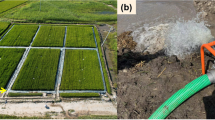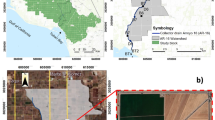Abstract
Nitrogen (N) and phosphorus (P) runoff loads of paddy fields in situ under conventional water and fertilizer management measures caused severe water pollution in the Taihu Lake basin. The “water balance method” was implemented to calculate the surface runoff and the N and P runoff loads of the paddy field for 2 years. The total inflow difference in the paddy field between the 2 years was 22.5% with more irrigation and less precipitation in 2013 than in 2014. The soil water depletion of the paddy field was in the range of 47.0–83.3 mm, accounting for an average of 6.4% of the total inflow. The surface runoff was mainly caused by precipitation and artificial drainage, but irrigation return flow should not be neglected in paddy fields in situ. The rainfall runoff volume accounted for an average of 42.2% of the total precipitation. The artificial drainages occurred mainly during the tillering stage of drying, during maturity stage of drying and when the water level was too high in the paddy field. More than half of the irrigation cases would occur as irrigation return flow, which accounted for an average of 11.8% of the irrigation. The variation in N and P concentrations in the surface runoff of the paddy field was predominantly governed by the times of fertilization. Compared to the irrigation volume control, the runoff pollution loads were predominantly governed by the fertilization rate. The mean reduction potential of N and P fertilization was 38.9 kg ha−1 and 7.5 kg ha−1, respectively. Reducing fertilizer rate is the effective way to improve the runoff pollution in paddy fields in the Taihu Lake basin.










Similar content being viewed by others
References
Allen RG, Pereira LS, Raes D, Smith M (1998) Crop evapotranspiration. Guidelines for computing crop water requirements. Fao Irrigation & Drainage Paper 56
Belder P et al (2004) Effect of water-saving irrigation on rice yield and water use in typical lowland conditions in Asia. Agr Water Manag 65(3):193–210
Bouman BAM, Wopereis MCS, Kropff MJ, Berge HFMT, Tuong TP (1994) Water use efficiency of flooded rice fields II. Percolation and seepage losses. Agr Water Manag 26(4):291–304
Bouman BAM, Humphreys E, Tuong TP, Barker R (2007a) Rice and Water. Adv Agron 92(04):187–237
Bouman M, Lampayan RM, Tuong TP (2007b) Water management in irrigated rice: coping with water scarcity, vol 54. International Rice Research Institute, Los Banos
Cao Y, Yin B (2015) Effects of integrated high-efficiency practice versus conventional practice on rice yield and N fate. Agr Ecosyst Environ 202:1–7
Chen QH et al (2016) Characteristics of nitrogen and phosphorus runoff losses in organic and conventional rice-wheat rotation farmland in Taihu Lake Region. J Ago-Environ Sci 35(8):1550–1558 (in Chinese with English abstract)
Choi JD, Park WJ, Park KW, Lim KJ (2013) Feasibility of SRI methods for reduction of irrigation and NPS pollution in Korea. Paddy Water Environ, 11(1–4):241–248
Guo L (2007) Doing battle with the green monster of Taihu Lake. Science 317(5842):1166
Guo HY, Wang XR, Zhu JG (2004) Quantification and index of non-point source pollution in Taihu Lake region with GIS. Environ Geochem Health 26(2):147–156
Guo JH et al (2010) Significant acidification in major Chinese croplands. Science 327(5968):1008–1010
Huang HC, Liu CW, Chen SK, Chen JS (2003) Analysis of percolation and seepage through paddy bunds. J Hydrol 284(1):13–25
Huang DF, Li WH, Wang LM, Lin XJ, Fan P, Qiu XX (2013) Effects of water and fertilizer managements on yield, nutrition uptake of rice and loss of nitrogen and phosphorus by runoff from paddy field. J Soil Water Conserv 27(02):62–66 (in Chinese with English abstract)
Huang NB, Su BL, Li RR, Yang WZ, Shen MM (2014) A field-scale observation method for non-point source pollution of paddy fields. Agr Water Manage 146:305–313
Inthavong T, Tsubo M, Fukai S (2011) A water balance model for characterization of length of growing period and water stress development for rainfed lowland rice. Field Crops Res 121(2):291–301
Jia GH, Yan JZ, Wang YY, Zhu FW (2013) Field test and research on agricultural water-saving irrigation and pollution reduction in Taihu Lake Basin. Yangtze River 44(3):81–84 (in Chinese with English abstract)
Jiang XS, Liu CL, Sui B, Dong CX, Guo SW (2012) Problems and proposals of the current fertilization situation in the rice-wheat rotation system in Tai Lake basin. Chin Agric Sci Bull 28(15):15–18 (in Chinese with English abstract)
Jiao JG et al (2018) Assessing of an irrigation and fertilization practice for improving rice production in the Taihu Lake region (China). Agr Water Manag 201:91–98
Jin SK, Oh SY, Oh KY (2006) Nutrient runoff from a Korean rice paddy watershed during multiple storm events in the growing season. J Hydrol 327(1):128–139
Khepar SD, Yadav AK, Sondhi SK, Siag M (2000) Water balance model for paddy fields under intermittent irrigation practices. Irrig Sci 19(4):199–208
Kim HK, Jang TI, Im SJ, Park SW (2009) Estimation of irrigation return flow from paddy fields considering the soil moisture. Agr Water Manag 96(5):875–882
Ladha JK, Krupnik TJ, Six J, Kessel CV, Pathak H (2005) Efficiency of fertilizer nitrogen in cereal production: retrospects and prospects. Adv Agron 87:85–156
Lin L, Zhang ZB, Janssen M, Lennartz B (2014) Infiltration properties of paddy fields under intermittent irrigation. Paddy Water Environ, 12(1):17–24
Liu YL, Zhou ZQ, Zhang XX, Xu X, Chen H, Xiong ZQ (2015) Net global warming potential and greenhouse gas intensity from the double rice system with integrated soil-crop system management: a three-year field study. Atmos Environ 116:92–101
Ongley ED, Xiaolan Z, Tao Y (2010) Current status of agricultural and rural non-point source pollution assessment in China. Environ Pollut 158(5):1159–1168
Peng SZ, Yang SH, Xu JZ, Luo YF, Hou HJ (2011) Nitrogen and phosphorus leaching losses from paddy fields with different water and nitrogen managements. Paddy Water Environ, 9(3):333–342
Peng SZ, He YP, Yang SH, Xu JZ (2015) Effect of controlled irrigation and drainage on nitrogen leaching losses from paddy fields. Paddy Water Environ, 13(4):1–10
Reidsma P et al (2012) Integrated assessment of agricultural land use policies on nutrient pollution and sustainable development in Taihu Basin, China. Environ Sci Policy 18(4):66–76
Rijsberman FR (2006) Water scarcity: fact or fiction? Agr Water Manag 79(1):5–22
Spiertz JHJ (2010) Nitrogen, sustainable agriculture and food security. A review. Agron Sustain Dev 30(1):43–55
Sun YJ et al (2012) The effects of different water and nitrogen managements on yield and nitrogen use efficiency in hybrid rice of China. Field Crops Res 127:85–98
Tan XZ, Shao Du, Liu HH, Yang FS, Xiao C, Yang HD (2013) Effects of alternate wetting and drying irrigation on percolation and nitrogen leaching in paddy fields. Paddy Water Environ, 11(1–4):381–395
Tan XZ, Shao DG, Liu HH (2014) Simulating soil water regime in lowland paddy fields under different water managements using HYDRUS-1D. Agr Water Manag 132(2):69–78
Tan XZ, Shao DG, Gu WQ, Liu HH (2015) Field analysis of water and nitrogen fate in lowland paddy fields under different water managements using HYDRUS-1D. Agr Water Manag 150:67–80
Tian YH, Yin B, Yang LZ, Yin SX, Zhu ZL (2007) Nitrogen runoff and leaching losses during rice-wheat rotations in Taihu Lake region, China. Pedosphere 17(4):445–456
Tsubo M, Shu F, Basnayake J, Tuong TP, Bouman B, Harnpichitvitaya D (2005) Estimating percolation and lateral water flow on sloping land in rainfed lowland rice ecosystem. Plant Prod Sci 8(3):354–357
Vitousek PM et al (2009) Nutrient imbalances in agricultural development. Science 324(5934):1519–1520
Vitousek PM, Porder S, Houlton BZ, Chadwick OA (2010) Terrestrial phosphorus limitation: mechanisms, implications, and nitrogen–phosphorus interactions. Ecol Appl 20(1):5–15
Wang HL, Sun ZZ, Li XY, Du XZ, Li WZ (2013a) Comparison and selection among nonpoint pollution models. Environ Sci Technol 36(5):176–182 (in Chinese with English abstract)
Wang WL, Liang T, Wang LQ, Liu YF, Wang YZ (2013b) The effects of fertilizer applications on runoff loss of phosphorus. Environ Earth Sci 68(5):1313–1319
Wang J, Wang DJ, Zhang G, Wang Y, Wang C, Teng Y, Christie P (2014) Nitrogen and phosphorus leaching losses from intensively managed paddy fields with straw retention. Agr Water Manag 141:66–73
Wu D (2015) Drainage processes and the lateral drainage effect of the main ditches on the paddy fields in the Plain River Network Regain. Xi’an University of Technology
Xu XP, He P, Yang FQ, Ma JC, Pampolino MF, Johnston AM, Zhou W (2017) Methodology of fertilizer recommendation based on yield response and agronomic efficiency for rice in China. Field Crops Res 206:33–42
Yao FX et al (2012) Agronomic performance of high-yielding rice variety grown under alternate wetting and drying irrigation. Field Crops Res 126(1):16–22
Ye Y, Liang X, Chen Y, Liu J, Gu J, Guo R, Li L (2013) Alternate wetting and drying irrigation and controlled-release nitrogen fertilizer in late-season rice. Effects on dry matter accumulation, yield, water and nitrogen use. Field Crops Res 144(6):212–224
Zhang HJ, Chen F (2010) Non-point pollution statistics and control measures in Taihu Basin. Water Resour Prot 26(3):87–90 (in Chinese with English abstract)
Zhao X, Xie YX, Xiong ZQ, Yan XY, Xing GX, Zhu ZL (2009) Nitrogen fate and environmental consequence in paddy soil under rice-wheat rotation in the Taihu lake region, China. Plant Soil 319(1–2):225–234
Zhao X, Zhou Y, Min J, Wang S, Shi W, Xing G (2012a) Nitrogen runoff dominates water nitrogen pollution from rice-wheat rotation in the Taihu Lake region of China. Agr Ecosyst Environ 156(4):1–11
Zhao X, Zhou Y, Wang SQ, Xing GX, Shi WM, Xu RK, Zhu ZL (2012b) Nitrogen balance in a highly fertilized rice-wheat double-cropping system in Southern China. Soil Sci Soc Am J 76(3):1068
Zhou JW, Su BL, Huang NB, Guan YT, Zhao K (2016) Runoff pollution experiments of paddy fields under different irrigation patterns. Environ Sci 36(4):1145–1152 (in Chinese with English abstract)
Acknowledgements
This work is supported by Major Project on Science and Technology of Water Body Pollution Control and Treatment (2017ZX07301) and National Natural Science Foundation of China (41772234).
Author information
Authors and Affiliations
Corresponding authors
Rights and permissions
About this article
Cite this article
Xu, Y., Su, B., Wang, H. et al. Analysis of the water balance and the nitrogen and phosphorus runoff pollution of a paddy field in situ in the Taihu Lake basin. Paddy Water Environ 18, 385–398 (2020). https://doi.org/10.1007/s10333-020-00789-5
Received:
Revised:
Accepted:
Published:
Issue Date:
DOI: https://doi.org/10.1007/s10333-020-00789-5




